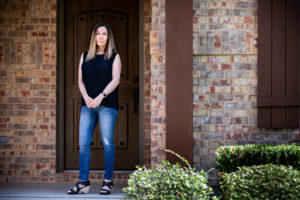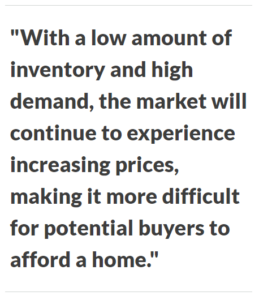Newsletter Signup
The Austin Monitor thanks its sponsors. Become one.
Most Popular Stories
- How Trump’s federal funding freeze is beginning to affect Austin
- APD won’t enforce SB 14 as Paxton and Trump further attack gender-affirming health care
- After shutting off mental health care for Austin musicians, SIMS Foundation restarts services
- Commercial EV station moves forward despite opposition
- Council approves call for better coordination, planning among downtown projects
-
Discover News By District
Popular Whispers
- Council Member Mike Siegel will speak out against cuts to federal services
- DAA offers a look at future of Sixth Street entertainment district
- City manager hosts community meetings on next year’s budget
- Zero Waste Advisory Commission adds own ‘no’ rec on merge with RMC
- Former church site offers mix of affordable, permanent supportive housing in SE Austin

Photo by Gabriel C. Pérez/KUT
Thousands are out of work, but home sales in Austin are doing fine — better than fine. What gives?
Tuesday, August 25, 2020 by Audrey McGlinchy, KUT
Blake Taylor wants to be rid of the house she hardly leaves.
Taylor lives with lupus, an autoimmune disease, and is terrified of what it would mean if she caught Covid-19. She’s been extra careful. When she heads to HEB to buy food, she goes as soon as it opens, hoping fewer people will be there. She wears gloves and a mask. When she gets home, she washes her unpackaged groceries.
The coronavirus pandemic hit right as she was about to put her Round Rock house up for sale. Taylor decided instead to stay put, afraid of prospective buyers getting her sick.
“When you think about strangers coming in your house, they want to look in the cabinets and the closets. They pretty much are touching everything,” Taylor, a retired court reporter, said. “Is it worth it?”
But then a house in the neighborhood sold in two days. Everyone was telling her it was a seller’s market, which is typical in Austin, but now, more so than usual. Taylor was eager to move from the house she’d gotten as part of her divorce. It was too big for her and too expensive to keep up.
“It’s best for me if I could get out from under such a giant house,” she said.
She thought she could use the market to the advantage of her health; if her house sold quickly, that meant less time potentially exposed to the virus.
Unemployment in Austin is more than double what it was this time last year. Thousands are out of work, either working fewer hours, furloughed or laid off. Yet home prices and sales in the Austin area are higher than normal, and houses are moving off the market faster than usual.
Experts say it’s the same old story of why Austin is such an expensive place to buy a home: There’s little supply and a lot of demand. The pandemic, with its nervous sellers and eager buyers, has simply exacerbated this.
Supply Is Down, More Than Usual
Real estate agents say people like Taylor are deciding not to list their homes right now either out of fear of catching Covid-19 or because of economic uncertainty. So, the number of homes for sale in the Austin area has significantly decreased.
Summer is typically the most active month for home sales, as families try to get into a new house before the school year starts. But according to the latest housing report from the Austin Board of Realtors, active listings were down a third in July compared to this time last year.
Another way to look at supply is in months of inventory. Right now, the area has 1.7 months of inventory of homes for sale. Put another way, at the current pace of sales, if no other homes came on the market, the current for-sale homes would sell in a little less than two months. That’s down a full month of inventory compared to this time last year.
The result is that homes are selling quickly.
“It’s incredible because when you put something on the market, it goes in usually within a week,” said Socar Chatmon-Thomas, who’s been a real estate agent in Austin for 20 years.
On average, homes for sale in the region are spending 44 days on the market, selling three days faster than they did this time last year.
This means competition to buy a house is even fiercer. KUT spoke to seven real estate agents for this story, many of whom shared stories of homes in Central Texas getting more than 10 purchase offers. One home in East Austin got 40 bids. Buyers are offering to lease the home back to the seller for free, offering tens of thousands of dollars above listing price and writing personal letters to edge out rival bidders.
Laura Kinnard and her husband thought it would be harder to sell their home than buy a new one in South Austin. But they accepted an offer for their three-bedroom house near the Travis County Expo Center in just four days, and made 13 offers on 13 different homes before one was finally accepted.
And they got it only after they offered $20,000 over the asking price – $360,000 for a home selling for $339,000.
“There were times that we were going to houses that had been on the market for hours,” Kinnard said.
In order to protect people during the pandemic, real estate agents and homeowners have been limiting the number of people allowed to tour a house, sometimes requiring would-be buyers to wear masks, gloves and booties over their shoes.
When Kinnard and her husband showed up, they had to wait in line to see the house – a product of both the pandemic and the market.
“That to me was so unreal – having to basically wait to even see the house and then knowing that you’re going to be competing with at least several of these people on offers, too,” she said. “It was really, really surprising and shocking.”
Mortgage Rates Are Very Low, So Demand Is Doing Fine
While sellers are staying home, homebuyers in Austin are still eager.
“I think a lot of people thought, ‘I’ll be the only one shopping right now,’” said Jeff Tucker, an economist with Zillow. “But that really hasn’t panned out. In a way, that’s a self-defeating mass belief. If everyone thinks that way, then you get a lot of buyers on the market and a lot of sellers sitting it out.”

Laura Kinnard and her husband accepted an offer on their home after just four days. Credit Gabriel C. Pérez
The main reason for that, experts say, is that mortgage interest rates are the lowest they’ve ever been. Prospective buyers have been able to get interest rates below 3 percent, compared to last year when they were closer to 4 percent.
Kinnard, who moves into her new house this week, was able to get an interest rate a whole percentage point lower than when she and her husband bought their first home.
This means those who can afford to buy right now can buy more.
“The power that (a low mortgage interest rate) gives you as a buyer is really huge,” Jen Klentzman, an Austin real estate agent, said. “You might have thought you needed to be at $300,000, but with the interest rate in the twos, you might be able to afford that $350,000 house. So, it’s allowing prices to stay up because buyers can afford more house.”
The median sales price in the Austin area is up 10 percent compared to last July, according to the Austin Board of Realtors. Experts caution that this may not represent rising home prices across the board. Instead, it may be that more expensive homes are the ones selling, since higher-income buyers, many of whom have kept their jobs through the pandemic, are the few able to buy a house right now.
What Comes Next?
Taylor, whose autoimmune disease has kept her at home during much of this pandemic, said once her house sells, she’ll look for a place to rent. She doesn’t want to buy another house right away, nervous about touring homes in this market.
“You don’t know if you’re going into somebody’s house that has the virus,” she said.
In its latest housing report the Austin Board of Realtors called the area’s current inventory of homes “dangerously low.” What’s dangerous, says the board’s president, is what such low inventory means for prices.
“With a low amount of inventory and high demand, the market will continue to experience increasing prices, making it more difficult for potential buyers to afford a home,” ABOR President Romeo Manzanilla wrote by email. “It would also drive competition within the market into a multiple/escalating offer situation and inflate prices to a point that could become unsustainable.”
But real estate agents and real estate economists predict Austin’s crazier-than-usual housing market should settle down in a couple months.
“We think that that is going to level off here into the fall,” Jim Gaines, chief economist at the Texas A&M Real Estate Center, said. “But it’s still going to be strong.”
Chatmon-Thomas worries that some homes may start coming on the market because their owners can’t afford to pay their mortgages any longer.
“We’re going to start seeing some pain,” she said. “Right now we don’t in Austin.”
Since the beginning of the pandemic, many homeowners have been able to put their mortgage into forbearance and pause payments for up to a year. But that money will eventually come due. And low-income homeowners may bear the brunt of that fallout. According to a recent Forbes article, forbearances on mortgages more often available to first-time homeowners and people with credit issues rose nearly 12 percent in one week.
“I’m sure we have people here in this city right now who have a mortgage … and are in forbearance,” Chatmon-Thomas said. “That person does not have a job and that person does not have the pandemic pay any more … what happens next?”
This story was produced as part of the Austin Monitor’s reporting partnership with KUT.
The Austin Monitor’s work is made possible by donations from the community. Though our reporting covers donors from time to time, we are careful to keep business and editorial efforts separate while maintaining transparency. A complete list of donors is available here, and our code of ethics is explained here.
You're a community leader
And we’re honored you look to us for serious, in-depth news. You know a strong community needs local and dedicated watchdog reporting. We’re here for you and that won’t change. Now will you take the powerful next step and support our nonprofit news organization?







